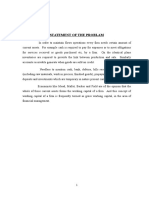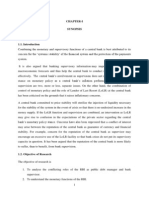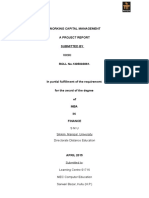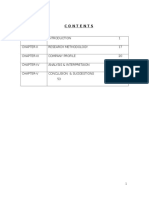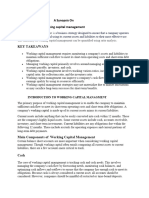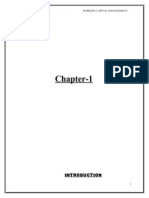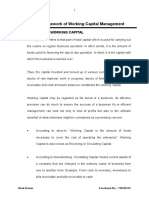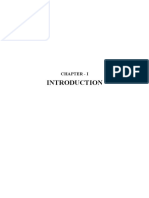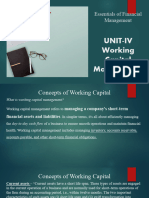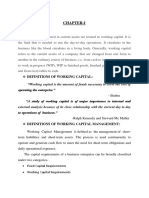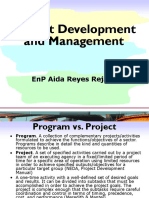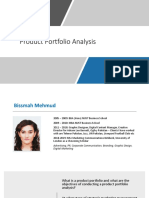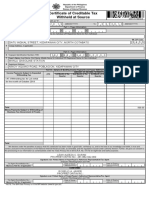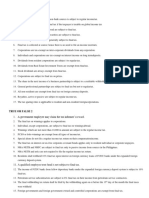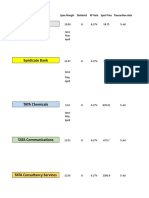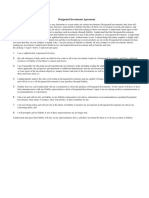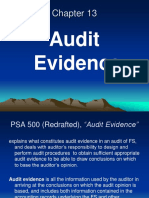Ultra Tech WCM (Anti Plagiarism Done)
Ultra Tech WCM (Anti Plagiarism Done)
Uploaded by
SudheerCopyright:
Available Formats
Ultra Tech WCM (Anti Plagiarism Done)
Ultra Tech WCM (Anti Plagiarism Done)
Uploaded by
SudheerOriginal Title
Copyright
Available Formats
Share this document
Did you find this document useful?
Is this content inappropriate?
Copyright:
Available Formats
Ultra Tech WCM (Anti Plagiarism Done)
Ultra Tech WCM (Anti Plagiarism Done)
Uploaded by
SudheerCopyright:
Available Formats
WORKING CAPITAL MANAGEMENT
CHAPTER -1
INTRODUCTION
INDUSTRY PROFILE
COMPANY PROFILE
PRODUCT PROFILE
GOKULAKRISHNA COLLEGE OF ENGINEERING- SULLURUPETA Page 1
WORKING CAPITAL MANAGEMENT
CHAPTER - 1
INTRODUCTION
Working capital is the money a business needs to run its day-to-day operations. It can
also be seen as the short-term total investment of the business. This business mainly consists
of raw materials, semi-finished products, finished goods, other debts, short-term investments,
etc. There is no business that does not need working capital. The main goal of every company
is to maximize the wealth of its shareholders.
A company needs to generate enough returns to make its shareholders rich. A successful
sales plan is necessary to generate steady profits. If enough money is invested in liquid
assets, the company can sell. The need for liquid assets is necessary because sales are not
immediately converted to cash. Converting sales into cash always involves a business cycle.
Working capital management is one of the most important aspects of financial
management. It plays the important role of financial managers and accountants. It focuses on
problems that arise when trying to manage current assets, short-term debt and the relationship
that exists between them. Current asset management is similar to fixed asset management and
in both cases analyzes its impact on company returns and risks.
DEFINITIONS OF WORKING CAPITAL:
“Working Capital refers to a firm’s investment in short-term Assets like cash, short-term
securities, Account receivables and inventories”.
-WESTON&BRIGHAM.
“Any acquisition of funds of which increase the Current Assets increase Working Capital
also, for the are one and the same
-BONNEVILE.
GOKULAKRISHNA COLLEGE OF ENGINEERING- SULLURUPETA Page 2
WORKING CAPITAL MANAGEMENT
WORKING CAPITAL MANAGEMENT
Financial management involves the management of finance functions it is concerned
with the planning, organizing, directing and controlling the financial activities of an
enterprise it deals mainly raising funds in the most economic and the suitable manner using
these funds as profitable as possible planned future development through financial account
cost accounting budgeting statistics and other means.
The finance function mainly deals with the following three functions:
1. Investment Decision
2. Finance Decision
3. Dividend Decision
Each of these function must concerned in relation to the objective of the firm.
Working capital management deals with the problems that arise when trying to
manage current assets, short-term liabilities and the relationship between them.
Current assets are assets that can or will be converted into cash within one year in the
normal course of business. The main current assets are cash, marketable products,
receivables and inventories. Current debt is debt that at its inception is intended to be paid
within one year in normal business. Current liabilities include accounts payable, notes, bank
loans and unpaid invoices.
The purpose of capital management is to manage the current assets and short-term
debts of the company in order to maintain an adequate level of working capital.
working capital to ensure the efficient operation and functioning of business
departments. Raw materials and goods, labor payments and electricity, water, taxes, etc. used
for other expenses. Working capital is required when performing routine production
operations and traditional production operations. This type of investment takes less time as
the customer can get a return on the investment when the product is sold to the customer.
GOKULAKRISHNA COLLEGE OF ENGINEERING- SULLURUPETA Page 3
WORKING CAPITAL MANAGEMENT
Meaning of working capital:
Generally, the term "working capital" refers to the ratio of capital a company needs to
operate or finance its current needs. Working capital is the cycle of all transactions. With or
without production, business cannot thrive without sufficient capital.
Insufficient working capital, some current assets minus current liabilities minus raw
materials, labor, etc. that do not provide economic benefits.
For this reason, it is a very economical product. This is why working capital is the wrong
term.
The working capital of the company has not been regulated. The term describes
management decisions that affect certain aspects of current assets and current liabilities. In
turn, these decisions should stem from the overall value of the company. Concepts of
working capital
The term working capital can be used in two different ways: they are
1. Gross Working Capital:
The gross working capital refers to investment in all the current assets taken together.
The total of investments in all current assets is known as gross working capital.
2. Net Working Capital:
The term net working capital refers to the excess of total current assets over total current
liabilities. It is worth noting that current assets are liabilities to be paid within one year.
Types of working capital:
From the point of view of time, the term working capital can be divided into two
categories.
1. Permanent working capital:
It also refers to hardworking resources. This is the minimum amount of investment the
business makes in liquid assets over a period of time to maintain our minimum operations.
2. Temporary working capital: It refers to the part of the total working capital needed by
the business that exceeds the fixed working capital. It is also known as variable working
capital. Since the cost of temporary working capital is constantly changing with the market, it
can be financed with short-term capital.
GOKULAKRISHNA COLLEGE OF ENGINEERING- SULLURUPETA Page 4
WORKING CAPITAL MANAGEMENT
Permanent working capital can be further divided into:
1. Regular Working Capital
2. Reserve Working Capital
1. Regular Working Capital:
It is the minimum amount of income required to complete the capital cycle from cash to
inventory, accounts receivable to cash. This is to reduce all costs, provide sufficient raw
materials, etc. It will contain the minimum balance for...NEED & IMPOTANCE OF
WORKING CAPITAL:
Adequate working capital helps manage the solvency of the business by providing uninterrupted
products.
Having adequate working capital helps build and maintain goodwill by allowing the business to
make timely payments.
Businesses with sufficient working capital, high solvency and good credit can obtain loans from
banks and other institutions on easy and good terms.
Adequate working capital also enables businesses to get discounts on purchases and thus reduce
costs.
Sufficient working capital to maintain normal production and continuous production.
Working capital cycle (or) Operating cycle:
The normal business operations of a manufacturing & trading company start with cash,
go through with the successive segments of the operating cycle, via, raw materials storage
period, conversion period, finished goods storage period & average collection period before
getting back cash along with profit. The total duration of all segments mentioned above is
known as gross operating cycle.
Operating cycle is the time duration required to convert sales after the conversion of
resources into inventories into cash. In other words, an operating cycle refers to length of
time necessary to complete. Working capital cycle is popularly known as Operating cycle.
The following cycle of events is:
GOKULAKRISHNA COLLEGE OF ENGINEERING- SULLURUPETA Page 5
WORKING CAPITAL MANAGEMENT
1.Conversion of cash into raw materials.
2.Conversion of raw materials into work in progress.
3.Conversion of work in progress into finished
goods.
4.inversion of finished goods into bills receivable through sales..
5.Conversion of bills receivable into cash.
Cash
Bills Raw
Finishe Work
Classifications of working capital:
Working capital may be classified in to two ways.
Working capital
On the basis of concept On the basis of time
Gross working capital Net working capital Permanent or Temporary or
Fixed working variable
Capital working capital
Gross working capital:
The gross working capital refers to the firms investment in the total current assets of the
enterprise. The current assets are those assets within the ordinary course of business can
converted into cash within the short period of normally one accounting year.
GOKULAKRISHNA COLLEGE OF ENGINEERING- SULLURUPETA Page 6
WORKING CAPITAL MANAGEMENT
Net working capital:
The net working capital can be defined into 2 ways :
1. Difference between current assets & current liabilities.
2. The portion of firm’s current assets.
Advantages of good working capital management
The main benefits of good working capital are:
Solvency of the business: adequate working capital helps maintain the solvency of the business
by providing an uninterrupted flow of production.
Goodwill: sufficient working capital to help the business make timely payments and thereby
create and maintain goodwill .
Easy Loans: Have sufficient working capital, weight and a good job.
Loan conditions can provide loans from banks on simple and good terms.
Reduced costs: Having adequate working capital also enables companies to reduce the cost of
purchasing and maintaining goodwill.
Continuous raw material supply: Sufficient working capital to ensure continuous raw material
supply and continuous production.
Regular payment of wages, salaries and other daily contracts: Companies with sufficient working
capital can make regular daily contract payments that will improve employee morale, increase
productivity, reduce waste, and increase profits and profits.
Making the most of the best business: Taking advantage of good products, such as focusing on
working capital, selling more items they need when the price drops, and keeping inventory at a
higher price.
Solving problems: Having adequate working capital makes companies more efficient in dealing
with economic problems such as depression and inflation.
Fast, regular return on investment: Having adequate working capital allows the business to pay
dividends to its investors quickly and regularly because return income may be low.
GOKULAKRISHNA COLLEGE OF ENGINEERING- SULLURUPETA Page 7
WORKING CAPITAL MANAGEMENT
Disadvantages of working capital:
It stops growing. Due to the lack of funds, it is difficult for the company to conduct profitable
operations.
Implementing business plans and meeting business goals will be difficult.
Efficiency is increasing and it is still difficult to keep up with daily promises.
There is no working capital and fixed assets are not used effectively.
Therefore, the company's revenue will be negative.
Lack of working capital prevents the company from taking advantage of attractive loans.
A company loses its credibility when it fails to meet its short-term goals. Therefore, the company's
credit is tight.
GOKULAKRISHNA COLLEGE OF ENGINEERING- SULLURUPETA Page 8
WORKING CAPITAL MANAGEMENT
INDUSTRY PROFILE
Capacity & production:
The Indian Cement Industry with total capacity of 151.2 million tons in March 2003 has
emerged as the second largest market after China, surprising developed nations like the USA
& Japan. Cement demand in the country grows roughly 1.5 times the GDP growth rate. The
industry has turnover of around US$ 7.8 billion in 2003-04 & it is expected to grow at a
CARG of around 9% in the next 5 Years.
Cement industry was released with price and distribution on March 1, 1989, licenses on
July 25, 2014. However, the performance and price of the cement business are constantly
monitored. The infrastructure management committee meeting was discussed by the
Executive Secretary, who was chair of the secretary, examining the constraints faced by the
business. Its performance is also reviewed by the Development Committee.
About the Cement:
Cement is the fine powder, which when mixed with water undergoes chemical change &
there after allowed to set & harden is capable of uniting fragments or masses of solid mater
together to produce a mechanically strong material. Cement can be used as binding material
with water, for bonding solid particles of different sizes like bricks stones are aggregate to
from a monolith. Cement used in construction of buildings & civil engineering works contain
compound of lime, silica & alumina as their principal constituents & can be called as
complex compounds.
Requirements:
Coal:-
The coal consumed in the dry process constitutes 20-25% of the clinker production. This
means that 0.20-0.25 tons of coal is used to produce one ton of clinker. This contributes to
35-40% of the production cost.
The cement industry uses around 10 million tons of coal each year. Due to the poor quality
of coal supplied by coal power plants such as BCCL, NCL and CCL, the industry has to
supply high quality coal with it. The calorific value of castor coal is low (3500-4000 kcal/kg)
and the ash content is as high as 25-30%. It is 6-7% lower. Lignite can also be mixed with
coal as a fuel. However, this process is not common.
GOKULAKRISHNA COLLEGE OF ENGINEERING- SULLURUPETA Page 9
WORKING CAPITAL MANAGEMENT
Electricity:-
The cement industry uses about 5.5 billion kilowatt-hours of electricity each year, and one
ton of cement requires about 120-130 kilowatt-hours of electricity. Energy costs vary by
factory location and production process. State governments provide these programs, so
factories in different states must have different electricity prices. Another big problem of the
sector is electricity.
Most cement producing states (like AP and MP) consume 25-30% of electricity each year,
causing production losses.
Infrastructure:-
To reduce uncertainty relating to power, most of the leading companies like ACC, Indian
Rayon, &Grasim rely on captive power plants. A few companies are also considering power-
generating windmills.
Limestone:
This is the largest in terms of cement input. About 1.6 tons of limestone are needed to
produce one ton of cement. For this reason, the location of the cement factory is determined
by the location of the limestone mine. The main income comes in the form of debt payments
to the central government and debt payments from the state governments.
The country's limestone reserves are estimated at one billion tons. AP has the highest
shares with 34%, Karnataka 13%, Gujarat 13%, MP 8% and Rajasthan 6.5%. Factories near
limestone deposits pay lower shipping costs than others.
Transportation:
Now most of the cement is packaged in paper bags. It is then transported by rail or road.
Transport over 200 km is non-commercial, so about 55% of cement is transported by rail.
There is a shortage of vehicles, especially on the Western and Southeastern Railways. In this
case, manufacturers are looking for sea routes that are both cheaper and reduce losses during
transportation.
Today, 70% of the cement shipped worldwide is made by sea, while in India this rate is
only 1%. But the situation has changed as many of the bigger players like L&T, ACC and
Grasim set up their own terminals.
GOKULAKRISHNA COLLEGE OF ENGINEERING- SULLURUPETA Page 10
WORKING CAPITAL MANAGEMENT
Infrastructure for future:
Cement consumption is determined by products related to housing and infrastructure,
water conservation, roads, drainage and water pipes. Level and growth and sectoral
composition of GDP, capital formation, financial use, population growth, level of urban
development etc. However, domestic cement demand mainly comes from the construction
and construction sector. The state paved the way for the private sector to enter the road
project. It amended the National Highways Act to allow private highway tolls and eliminate
competition for private construction, bridges, highways.
The fund provides incentives to private construction companies. Continued liberalization
will lead to increased trade and infrastructure development. Therefore, expect the Indian
cement industry to be more prosperous in the future.
Incentives in states:
Most of the state governments, in order to attract investments in their respective states,
offer fiscal incentives in form of sales tax exemption/deferrals. In some states, this applies
only to intrastate sales, like Madhya Pradesh & Rajasthan. States like Haryana offer a freeze
on power tariffs for 5 years, while Gujarat offers exemption from electric duty.
Installed Capacity:
India is the world’s 2nd largest cement producing country after China. The industry is
characterized by a high degree of fragmentation that has created intense competitive pressure
on price realization. Spread across the length breath of the country, there are 120 large plants
belonging to 56 companies with an installed capacity of around 135mn tons as a on
March2014.
Procedure:
The main materials used in cement production are limestone, sand, shale, clay and iron
ore. Limestone, the main material, is usually mined on site, while other secondary materials
can be mined at or near the job site. Another source of raw materials is industrial by-
products. Replacing raw materials with by-products is a key element in achieving sustainable
development.
GOKULAKRISHNA COLLEGE OF ENGINEERING- SULLURUPETA Page 11
WORKING CAPITAL MANAGEMENT
Raw Material Preparation:
Limestone mining requires the use of drilling and blasting equipment. Sandblasting uses
the latest technology to ensure vibration, dust and noise emissions are kept to a minimum.
Sandblasting produces objects of various sizes, from 1.5 meters in diameter to objects less
than a few millimeters in diameter. The material is transported to the crushing plant by being
transported to trucks on the crushing surface.
Thanks to crushers and sieves, limestone is reduced below 100 mm and stored until
needed. Depending on its size, secondary materials (sand, shale, clay and iron ore) may or
may not be crushed and stored in a separate area until needed.
Raw Grinding:
In the wet process, all raw materials are divided to meet the desired chemical
composition and fed to the rotating stone with water. The raw materials are ground to a size
where most materials are smaller than 75 microns. The material coming out of the mill is
called "slurry" and has a flow feature. This slurry is placed in a mixing tank and
homogenized to ensure the slurry has the correct chemical composition. After
homogenization, the slurry is stored in a tank until needed.
In the dry process, all raw materials are proportioned to meet the desired chemical
composition and fed into the stone field or vertical roller mill. The raw material is air dried
and ground to below 75 microns for most products. The dry product obtained from both types
of mills is called "bakery feed". The kiln feed is pneumatically mixed to ensure adequate
homogenization of the chemical composition of the kiln feed and then stored in silos until
needed.
Proprocessing:
The same reaction occurs whether the process is wet or dry. The basic chemicals are:
evaporate all the water, calcine the limestone to produce free calcium oxide, and make
calcium oxide with secondary materials (sand, shale, clay and iron). This results in the final
black, spherical material called "clinker" that has the desired hydraulic properties. In the wet
process, the slurry is fed into the furnace, which can be 3.0 m to 5 m long.Diameter 0m,
length 120.0m to 165.0m. The electric stove is made of steel and covered with special
refractories to protect it from hot processing.
GOKULAKRISHNA COLLEGE OF ENGINEERING- SULLURUPETA Page 12
WORKING CAPITAL MANAGEMENT
In the dry process, the energy is sent to the preheating tower, which can reach a height of
150.0 meters. The material from the preheating tower is discharged into the blast furnace,
which has the same diameter as the wet process but is shorter, approximately
×45.0 m. The preheating tower and rotary kiln are made of steel and lined with special
refractory materials to protect them from high process temperatures.
The electric stove ignites the fire made by burning coke, gas, oil or waste oil, regardless of
the process used. The preheating tower can also be equipped with electrical equipment.
Rotary Kiln transforms the hot clinker into cold clinker with a strong flame. The clinker
cooler recovers heat from the clinker and returns it to the heat treatment system, reducing
fuel consumption and increasing energy efficiency. The clinker remaining in the cold clinker
is at the correct temperature for processing on standard equipment.
Finish Grinding and Distribution:
Black, spherical clinker is stored on site in silos or clinker domes until needed for cement
production. Clinker, gypsum and other process additives are ground together in concrete to
form the final cement product. The quality of the final product, the amount of gypsum added
and the amount of process additives vary to achieve the desired properties in each final
cement product. All cement products are stored in one of the silos until the customer needs
them. Cement can be delivered in bulk by car, train or water according to the customer's
needs. Cement can also be packed in color or colorless and delivered by car or train.
Manufacture of Cement:
Portland cement is made by grinding a mixture of limestone, clay and other hardening
materials. Laterite, bauxite etc. The main components are lime, silica, alumina and iron
oxide. The manufacturing process is to finely pulverize the raw materials, mix them well and
bake them in an oven at about 1400°C. c.
The resulting product is called clinker. The clinker is cooled and ground into a fine
powder with gypsum. The final product is cement.
GOKULAKRISHNA COLLEGE OF ENGINEERING- SULLURUPETA Page 13
WORKING CAPITAL MANAGEMENT
Types of cement:
There are many types of cement in the market to suit every need. Some of them which are
included in the revised IS: 456-2000 is as follows:
•Ordinary Portland Cement 33, 43, 53 grades (OPC), 53-S (Sleeper Cement)
•Portland Pozzolana Cement (PPC), both Fly Ash and Calcined Clay based
• Rapid Hardening Portland cement
• Portland Slag Cement (PSC)
• Sulphate Resisting Portland cement (SRC)
• Low Heat Portland cement
• Hydrophobic Cement
Even though only Ordinary Portland Cement is graded according to strength, the other
cements too have to gain a particular strength. 33, 43 and 53 grade in OPC indicates the
compressive strength of cement after 28 days when tested as per IS: 4031-1988, e.g., 33
Grade means that 28days of compressive strength is not less than 33 N/mm2 (MPa) .
Similarly for 43 grades and 53grades the 28 days compressive strength should not be less
than 43 and 53 MPA respectively. 43 and53 grade are also being introduced in PPC and PSC
shortly by the Bureau of Indian Standards (BIS).
Ordinary Portland cement (OPC):
Ordinary Portland cement is the most widely used cement and has many uses. These
applications include dry mixes, ready mixed concrete and even reinforced precast and
prestressed concrete.
Portland Pozzolana Cement (PPC):
Portland pozzolana cement is ordinary Portland cement blended with pozzolanic materials
(power-station fly ash, burnt clays, ash from burnt plant material or siliceous earths), either
together or separately. Portland clinker is ground with gypsum and pozzolanic materials
which, though they do not have cementing properties in themselves, combine chemically
with Portland cement in the presence of water to form extra strong cementing material which
resists wet cracking, thermal cracking and has a high degree of cohesion and workability in
concrete and mortar.
GOKULAKRISHNA COLLEGE OF ENGINEERING- SULLURUPETA Page 14
WORKING CAPITAL MANAGEMENT
Portland blast furnace slag cement:
Portland blast furnace slag cement contains up to 70% finely ground granular blast
furnace slag, a non-metallic material composed of silicates and calcium aluminates. The slag
benefits from the energy invested in the slag process. Substituting slag for cement uses only
25% of the energy required to produce Portland cement. Using slag cement to replace some
of the Portland cement in your concrete mix is a great way to make your concrete look
brighter and more consistent. Portland blast furnace slag cement has a lighter color, better
workability, more flexible, stronger compressive and flexural strength, lower permeability,
better for chemical corrosion products and similar plastics and hardened counterparts.
DEVELOPMENT OF CEMENT INDUSTRY:
The Demolition of all control on the cement industry has created conditions of a glut in
the market worth the result that shortages have completely disappeared though prices have
not fallen. Between 2011-2012 &2014-2015 the rise in production has been of the order of
six million tons a year and yet the go downs of the wholesalers and the retailers are fill of
cement bag. The construction of industry has not complained about the capacity of cement in
a part of the country since 2015march.
The time is come when the industry should maximize the utilization of available capacity.
It is possible to set up demand for cement by promoting its use in road construction and
canalizing. The Union and State Government should pay due attention to this aspects of the
problem. Further efforts should be directed towards improvement in capacity utilization. Top
priority should be given in power and coal consumption.
PROBLEMS OF CEMENT INDUSTRY:
Cement Industry is an important core industry for national economy and this fact is well
recognized by the government. It is very much evident from the attention as well as from
policy support is receives continuously today. At all is not well worth it. The industry on tie
average of sickness from which it is not easy to recover, if smoothing is not done immediate.
Some of the general problems are enlisted below
1. Conversion of the existing dry process rotary kilns to either dry processor semi-dry
process
GOKULAKRISHNA COLLEGE OF ENGINEERING- SULLURUPETA Page 15
WORKING CAPITAL MANAGEMENT
2. Conversion of the existing dry process suspension preheated kilns pre calcinations.
3. Availability of raw factories, materials, especially lime.
4. Strategy of mini cement-plants.
5. Low receipts and low quality of coal.
Demand & Supply:
The driving needs for the cement industry are still housing, infrastructure and
construction, among others. As support for infrastructure continues to increase, we expect the
system to all needs ratio to increase in the future. Between April and November 2007, cement
demand increased by 10% year-on-year due to the growth of end users such as residential and
residential. CRISIL Research expects demand to remain stable and grow more than 12%.
next 2 years. With not much capacity coming from the river, demand for cement should
exceed product in the next year and a half, which will be enough for cement producers to
raise the price.
Today, cement from Andhra Pradesh is sold all over India, including Assam, Meghalaya,
Jharkhand, Odisha, West Bengal, Chhattisgarh, Gujarat and Malta. Maharashtra. Given the
reduction in sales tax, more cement could enter Tamil Nadu from the state. Further increase
in demand in South India will benefit the cement industry there. Cement supplies from
Gujarat to Mumbai have also decreased due to exports, while cement supplies from Odisha to
Andhra Pradesh have stalled, and cement is actually flowing into Odisha as well. Single-
family homes consumed 65% of all household consumption in 2013 and early 2014.
Housing use may drop to 55% as some infrastructure projects begin, while infrastructure
and other projects are expected to increase from the current 35% to 45%. Still, the main
consumption area is real estate, which includes commercial space and accounts for more than
60%. The state's 2013-14 demand is now expected to exceed 15 million tonnes (11.5 million
tonnes). We hope the demand here will exceed the 17th.
Considering the state's ongoing water and infrastructure projects, the $5 million mark
will be invested in 2014-15. Apart from some private and public infrastructure projects, the
construction of buildings, public toilets and rural schools in disadvantaged areas will also
contribute to the use of cement in the state. In this case, water projects worth close to Rs 100
million will generate unprecedented demand in the next 5-7 years. Cement consumption is as
follows
GOKULAKRISHNA COLLEGE OF ENGINEERING- SULLURUPETA Page 16
WORKING CAPITAL MANAGEMENT
ZONAL CONSUMPTIONS
ZONE 2016-2017 2020-
2021
EAST 17 17
SOUTH 26 30
NORTH 21 20
WEST 20 18
CENTRAL 17 16
TOTAL 101 101
Demand Drivers
Indian cement demand skewed towards housing the demand from the housing sector is
~53% of the total Indian cement demand.
GOKULAKRISHNA COLLEGE OF ENGINEERING- SULLURUPETA Page 17
WORKING CAPITAL MANAGEMENT
There are fears of a slowdown in the demand from the housing sector due to a drop in real
estate prices in the country. The worry is that builders may postpone construction of new
buildings if the property prices were to correct.
Infrastructure to give demand a big boost
Our analysis shows that Infrastructure should be the biggest growth driver for cement
demand in the country. If we were to look only at order books of the top eight construction
and manufacturing equipment companies in India, we find that their combined order book
has virtually doubled over the last two years fromINR1,000bn (USD25bn) to INR1,950bn
(USD48.75bn) for completion over the next24-30 months .
Main Companies in India:
GOKULAKRISHNA COLLEGE OF ENGINEERING- SULLURUPETA Page 18
WORKING CAPITAL MANAGEMENT
1.3 COMPANY PROFILE
ADITYA BIRLA GROUP:
BUSINESS OVERVIEW & BENCHMARKS:
Aditya Birla Group is a US$35 billion senior conglomerate included in the Fortune 500. It
has a unique strength of 133,000 employees from 42 different countries. The group was
named "Top Employer in India" by Hewitt Economic Times and The Wall Street Journal in a
2007 survey in India and was ranked among the top 20 in Asia. More than 50% of its revenue
comes from overseas operations. The group operates in 25 countries - India, UK, Germany,
Hungary, Brazil, Italy, France, Luxembourg, Switzerland, Australia, USA, Canada, Egypt,
China, Thailand, Laos, Indonesia, Philippines, Dubai, Singapore, Myanmar, Bangladesh ,
Vietnam, Malaysia and South Korea.
Globally the Aditya Birla Group is:
A metals powerhouse, among the world‘s most cost-efficient aluminum and copper
producers. Hindalco-Novelis is the largest aluminum rolling company. It is one of the 3
biggest producers of primary aluminum in Asia, with the largest single location copper
smelter.
No. 1 in Viscose staple fiber.
No.1 in carbon black
The fourth largest producer of insulators.
The fifth-largest producer of acrylic fibre
Among the top 10 cement producers
The largest Indian MNC with manufacturing operations in the
USA Among the best energy efficient fertilizer plant
In India
A top fashion (branded apparel) and lifestyle player
The second-largest player in viscose filament yarn
The 2nd largest in the Chlor-alkali sector.
Among the top 3 mobile telephony companies.
GOKULAKRISHNA COLLEGE OF ENGINEERING- SULLURUPETA Page 19
WORKING CAPITAL MANAGEMENT
A leading player in Life Insurance and Asset Management.
Among the top 2 super-market chains in the Retail Business.
Among top 10 BPO companies.
Rock solid in fundamentals, The Aditya Birla Group nurtures a culture where success
does not come in the way of the need to keep learning afresh to keep experimenting.
Beyond Business – The Aditya Birla Group is:
Working in 3000 villages.
Reaches out to 7 million people annually through the Aditya Birla Centre for Community
Initiatives and Rural Development, spearheaded by Mrs. Rajshree Birla.
Focusing on: health care, education, sustainable livelihood, infrastructure and espousing
social causes.
Running 41 Schools and 18 Hospitals.
VISION:
To be a premium global conglomerate with a clear focus on each business.
MISSION:
To deliver superior value to our customers, shareholders, employees and society
at large.
VALUES:
Integrity
Commitment
Passion
Seamlessness
Speed
GOKULAKRISHNA COLLEGE OF ENGINEERING- SULLURUPETA Page 20
WORKING CAPITAL MANAGEMENT
HISTORY:
Civil engineer Soren Kristian Toubro and chemical engineer Henning Holck Larsen,
founder of Larsen & Toubro (L&T), were classmates and went to the same engineering
school in Denmark. Both joined after they became engineers and the company was named
"F".
L. Smith & Company' is a cement manufacturing company. The two later came to India in
1935 to represent F. in the assessment of the cost of various cement production batches.
L. Smith & Company M/S Copenhagen. These groups were later combined to form the
Consolidated Cement Company. After completing this mission, F.L. They looked for a
suitable place.
During their business, the two of them visited India, saw the people there and decided to
start a business here. By making cooperation on May 1, 1938, pasteurizer, butter separator,
cream separator etc., which were not used due to World War II, were produced. they began to
repair foreign equipment. Gradually, they began to develop and produce many of these and
other dairy products. Soon, L&T was recognized as a reliable manufacturer with high
standards.
L&T entered the cement industry in 1980. L&T established its first factory in 1983 in
Awarpur, Maharashtra. The second factory was opened in 1991 in Hirmi, MP. The third and
largest factory was established in 1996 in Kovaya, Gujarat.In 1998, four factories were
opened in Tadipatri, AP.
GOKULAKRISHNA COLLEGE OF ENGINEERING- SULLURUPETA Page 21
WORKING CAPITAL MANAGEMENT
PROFILE
Grasim's company, UltraTech Cement Limited, has an annual production capacity of 18.2
million tons. It produces and sells ordinary Portland cement, blast furnace slag Portland
cement, and pozzolan Portland cement.
UltraTech has five mixing plants, five grinding and three terminals, two in India and one
in Sri Lanka. These include the plantation and two crushing units of the former Narmada
Cement Company Limited, which was acquired in May 2014.
UltraTech is the largest cement clinker exporter in the country. The company exports more
than 4,444 tons from 2.5 million tons per year, which constitutes 30 percent of the country's
total exports. The export market covers countries around the Indian Ocean, Africa, Europe
and the Middle East.
In 2004, L&T's cement division split after 30% of Grasim's shares were sold to the public,
giving it control of a new company, UltraTech.
The acquisition, which has long-term economic benefits, brought great synergy to the
parent company with the growth in cottages and buildings as well as increased cement
demand.
Ready-Mixed Concrete is likely to grow in the coming years. Realizing that the market
will expand this time, UltraTech started mixed concrete production throughout the country.
Ultra Tech Cement Limited (formerly L&T Cement Ltd.) is a well-known name in the
agricultural industry. The registered office and headquarters of the company is in Mumbai.
The company's reputation is based on a strong customer base, the technology of its
products and a strong track record of success. Ultra Tech has embarked on a transformation
process to ensure it becomes a known joint venture as soon as possible. The latest technology
is used in all its factories. Ultra Tech Cement has a profitable and cost-effective product in
various markets.
Ultra Tech is committed to high growth and delivering significant value to its customers
and members.
Ultra Tech has a worldwide network of factories, offices and sales offices. Authorized
dealers with the largest supply of the company's products, including cement, are located
directly or indirectly in all regions of the country.
GOKULAKRISHNA COLLEGE OF ENGINEERING- SULLURUPETA Page 22
WORKING CAPITAL MANAGEMENT
UltraTech's subsidiaries are: Dakshin Cements Limited and UltraTech Ceylinco (Private)
Limited.
ULTRATECH CEYLINCO (PVT LIMITED):
Ceylinco insurance company limited and UltraTech have incorporated this subsidiary in Sri
Lanka.
Ceylinco is one of the most respected business groups in Sri Lanka with activities in the field
of banking, insurance and finance.
A bulk Cement terminal has been established near Colombo with annual output of 0.5 MT.
Cement in bulk is sourced from Ultra Tech‘s Gujarat Cement works and transported by
carriers to Colombo.
NARMADA CEMENT COMPANY LIMITED.
The Narmada Cement Company Ltd. At Jafrabad (Gujarat) and two grinding units at
Magdalla (Gujarat) & Ratnagiri (Maharashtra) all are port-based plants. Clinker is shipped by
sea from Jafrabad to the grinding units.
GOKULAKRISHNA COLLEGE OF ENGINEERING- SULLURUPETA Page 23
WORKING CAPITAL MANAGEMENT
Milestones:
As part of the eighth biggest cement manufacturer in the world, UltraTech Cement has
five integrated plants, five grinding units as well as three terminals of its own (one overseas,
in Colombo, Sri Lanka). These facilities gradually came up over the years, as indicated
below:
2021: Narmada Cement Company Limited amalgamated with UltraTech pursuant to a
Scheme of Amalgamation being approved by the Board for Industrial & Financial
Reconstruction (BIFR) in terms of the provision of Sick Industrial Companies Act (Special
Provisions)
2020: Completion of the implementation process to demerge the cement business of L&T
and completion of open offer by Grasim, with the latter acquiring controlling stake in the
newly formed company UltraTech
2019: The board of Larsen & Toubro Ltd (L&T) decides to demerge its cement business
into a separate cement company (CemCo). Grasim decides to acquire an 8.5 per cent equity
stake from L&T and then make an open offer for 30 per cent of the equity of CemCo, to
acquire management control of the company.
2018:The Grasim Board approves an open offer for purchase of up to 20 per cent of the
equity shares of Larsen & Toubro Ltd (L&T), in accordance with the provisions and
guidelines issued by the Securities & Exchange Board of India (SEBI) Regulations, 1997.
Grasim increases its stake in L&T to 14.15 per cent Arakonam grinding unit
GOKULAKRISHNA COLLEGE OF ENGINEERING- SULLURUPETA Page 24
WORKING CAPITAL MANAGEMENT
2021:
Grasim acquires 10 per cent stake in L&T. Subsequently increases stake to 15.3 per cent
by October 2002. Durgapur grinding unit
2019-2020:
Bulk cement terminals at Mangalore, Navi Mumbai and Colombo
2018:
Narmada Cement Company Limited acquired
Ratnagiri Cement Works
2017:
Gujarat Cement Works Plant II
Andhra Pradesh Cement
Works 2016:
Gujarat Cement Works Plant I
2015:
Hirmi Cement Works
2014:
Jharsuguda grinding unit
2013:
Awarpur Cement Works Plant II
2012:
Awarpur Cement Works Plant I
GOKULAKRISHNA COLLEGE OF ENGINEERING- SULLURUPETA Page 25
WORKING CAPITAL MANAGEMENT
UltraTech cement Grinding units, Terminals and Cement plants:
ULTRATECH CEMENT LIMITED
AP CEMENT WORKS LIMITED, TADIPATRI
(UNIT OF ULTRATECH CEMENT LIMITED)
Introduction:
A P Cement Works (APCW) is located on the picturesque hilly area near Tadipatri at the
border line between Anantapur and Kurnool Districts in Rayalseema area of Andhra Pradesh.
APCW is a magnificent testimony of the Group's ability to transform the rocky terrains into a
place of gigantic cement manufacturing unit, which is a jewel in the crown of the fast
growing Aditya Birla Cement Group. APCW manufacturers a wide range of premium brand
of cements. The plant with an installed Capacity of 2.00 MTPA was commissioned in April
1998 and has been upgraded to 2.70 MTPA over a period of six years through several
improvements / modifications. The plant was expanded in 2008 by adding another 3.40
MTPA to its existing capacity and is today considered as one of the largest capacity plant at a
single location in India. The unit has also established a Thermal Power Plant of 2 X 25 MW
capacity to cater Cement plant's Power requirement.
Tadipatri, which is an ancient temple town, is located in Anantapur District of Andhra
Pradesh. The total area of the plant is about 1800 acres. APCW is located 360 kms South of
Hyderabad in the state of Andhra Pradesh in South India. Along with its Grinding Units at
Arakonam (Tamil Nadu) & Ginigera (Karnataka), it has a capacity of 8.00 million tons of
cement per annum. The Unit is certified for Quality, Environment, OHSAS & NABL
management systems. APCW's Manpower Strength as on date is 615 (Management, Staff
and permanent workmen)\
GOKULAKRISHNA COLLEGE OF ENGINEERING- SULLURUPETA Page 26
WORKING CAPITAL MANAGEMENT
CHAPTER – 2
REVIEW OF LITERATURE
GOKULAKRISHNA COLLEGE OF ENGINEERING- SULLURUPETA Page 27
WORKING CAPITAL MANAGEMENT
2. REVIEW OF LITERATURE
2.1MEANING OF WORKING CAPITAL:
Working capital management refers to a company's investments in short-term assets such
as cash, marketable products, inventory, and accounts receivable. Working capital is the
portion of current assets that exceeds short-term liabilities. It represents the bank's investment
in assets that need to be completed in a short time.
All current assets and current liabilities are part of working capital. It is necessary to
measure the increase or decrease in the working capital by preparing the change table.
This report has been prepared on the basis of current assets and short-term liabilities
shown in the balance sheet. This disclosure shows individual changes in current assets and
current liabilities and their effects on working capital.
Every business needs money for two purposes: to start the business and to operate on a
daily basis. Building a factory requires long-term investment. Money is also needed in the
short run to purchase raw materials and pay for labor and other daily expenses. These funds
are called working capital.
Working capital is the portion of the company's capital that must be paid in the short term
or immediately, such as cash, merchandise, debt and inventory. Investments in liquid assets
continue to move rapidly and turn into cash.
Definitions:
1. “Working capital the amount of funds necessary to cover the cost of operating the
enterprise”
-SHUBIN
2. “Circulating capital means current assets of a company that are changed in the ordinary
course of business from one form to another”
-GERESTENBERG
3. “Working capital is descriptive of that capital which is not fixed. But, the more common
use of working capital is to consider it as the difference between the book value of the
current assets and the current liabilities. ”
-HOAGLAND
GOKULAKRISHNA COLLEGE OF ENGINEERING- SULLURUPETA Page 28
WORKING CAPITAL MANAGEMENT
4.”Working capital refers to a firm’s investment in short term asset, cash, short term
securities, accounts receivable & inventories.”
-WEST & BRIGHAM
5.“Any acquisition of funds which increases the current asset increase the working capital
also, for they are one & the same.”
-BONNEVILLE
NEED&IMPOTANCE OF WORKING
CAPITAL:
Adequate working capital helps in maintaining solvency of the business by providing
uninterrupted flow of production.
Sufficient working capital enables a business concern to make prompt payments & hence
helps in creating & maintaining goodwill.
A concern having adequate working capital, high solvency & good credit standing can
arrange loans from banks & others on easy & favorable terms.
Adequate working capital also enables a concern to avail cash discount on the purchase &
hence it reduces costs.
Sufficient working capital ensures regular supply of raw materials & continuous production.
Adequate working capital enables a concern to face business crisis in emergencies such as
depression because during such periods, generally, there is much pressure on working
capital.
Disadvantages of working capital:
It stagnates growth. It becomes difficult for the firm to undertake profitable projects due to
inadequate of funds.
It becomes difficult to implement operating plans & achieve firms profit targets.
Operating efficiencies creep in & it becomes difficult even to meet day-to-day
commitments.
Fixed assets are not efficiently utilized for the lack of working capital funds. Thus the
firm’s profit would deteriorate.
Paucity of working capital fund renders the firm unable to avail attractive credit
opportunities.
The firms losses its reputation when it is not in a position to honor its short term
obligations. As a result, the firm tight credits terms.
GOKULAKRISHNA COLLEGE OF ENGINEERING- SULLURUPETA Page 29
WORKING CAPITAL MANAGEMENT
Working capital cycle (or) Operating cycle:
The normal business operations of a manufacturing & trading company start with cash,
go through with the successive segments of the operating cycle, via, raw materials storage
period, conversion period, finished goods storage period & average collection period before
getting back cash along with profit. The total duration of all segments mentioned above is
known as gross operating cycle.
Operating cycle is the time duration required to convert sales after the conversion of
resources into inventories into cash. In other words, an operating cycle refers to length of
time necessary to complete. Working capital cycle is popularly known as Operating cycle.
The following cycle of events is:
1.Conversion of cash into raw materials.
2.Conversion of raw materials into work in progress.
3.Conversion of work in progress into finished
goods.
4. inversion of finished goods into bills receivable through
sales.. 5.Conversion of bills receivable into cash.
Cash
Bills receivable Raw material
Finished goods Work in progress
GOKULAKRISHNA COLLEGE OF ENGINEERING- SULLURUPETA Page 30
WORKING CAPITAL MANAGEMENT
Nature of working capital:
Capital management deals with the problems that arise when trying to manage current
assets, short-term debt and the relationship that exists between them. The term current assets
refers to assets that, in an ordinary business, are convertible or will be converted into cash
without depreciation within one year and affect the performance of the company. The main
current assets are cash, marketable products, receivables and inventories. Current liabilities
are liabilities that are expected to be paid within one year from current assets or operating
incomes in the normal operation of the business. Current liabilities include accounts payable,
notes, bank loans and unpaid invoices.
The purpose of capital management is to manage the current assets and liabilities of the
company to maintain an adequate level of working capital. This is because if the company
fails to raise a high level of working capital, it goes bankrupt and is forced into bankruptcy.
To ensure adequate security, current assets must be sufficient to meet current liabilities. All
liquid assets must be properly managed to maintain the stock of the company without having
to keep an asset at a high level. All short-term sources of finance must be continuously
monitored to ensure that they are received and used effectively.
For the purpose of raw materials, components and spares.
To pay wages and salaries.
To incur day-to-day expenses etc.
To meet the selling costs such as packing and advertising.
To provide credit facilities of raw materials, work-in-progress, stores, shares and
finished stock.
GOKULAKRISHNA COLLEGE OF ENGINEERING- SULLURUPETA Page 31
WORKING CAPITAL MANAGEMENT
2.3Classifications of working capital:
Working capital may be classified in to two ways.
Working capital
On the basis of concept On the basis of time
Gross working capital Net working capital Permanent or Temporary or
Fixed working variable
Capital working capital
Gross working capital:
The gross working capital refers to the firms investment in the total current assets of the
enterprise. The current assets are those assets within the ordinary course of business can
converted into cash within the short period of normally one accounting year.
Net working capital:
The net working capital can be defined into 2 ways :
1. Difference between current assets & current liabilities.
2. The portion of firm’s current assets.
Permanent or Fixed working capital:
Permanent or Fixed working capital is the minimum amount which is required to ensure
effective utilization of fixed facilities & for maintaining the circulation of current
assets.There is always a minimum level of current assets which is continuously required by
the enterprise to carry out its normal business operations.
Temporary working capital:
Temporary or variable working capital is the amount of working capital which is required
to meet the seasonal demands & some special exigencies. Most of the enterprises have to
provide additional working capital to meet the seasonal & special needs. It is also called as
seasonal working capital.
GOKULAKRISHNA COLLEGE OF ENGINEERING- SULLURUPETA Page 32
WORKING CAPITAL MANAGEMENT
Statement of changes in Working capital
S.no Particulars Previous Current Increase Decrease
year year
A. Current assets:
Inventories *** *** *** -
Debtors *** *** *** -
Cash & bank balance *** *** *** -
Loans & advance *** *** *** -
Total current assets **** ****
Current liabilities:
Currents liabilites *** *** - ***
B.
Provisions *** *** - ***
Total current liabilities *** ***
Working capital(A-B) *** ***
*** ***
Decrease in workingcapital -
- ***
***
Networking capital **** ****
****
****
GOKULAKRISHNA COLLEGE OF ENGINEERING- SULLURUPETA Page 33
WORKING CAPITAL MANAGEMENT
Formula uses for data analysis and interpretation:
Current ratio:
The current ratio is a measure of the firm’s short-term solvency. It indicates the
availability of current assets in rupees for every one rupee of current liability. Current assets
include cash and those assets which can be converted into cash within a year, such as
marketable, debtors and Inventories. All obligations maturing within a year are included in
current liabilities. Current liabilities include creditors, bills payable, accrued expenses, short-
term bank loan, income-tax liability and long-term debt maturing in the current year.
The current ratio is calculated by dividing current assets by current liabilities;
The current ratio represents a margin of steady for creditors. The higher current ratio, the
Current assets
greater margin of safety, the larger amount of the assets in relation to current liabilities, the
Current ratio =
firm’s ability to meet its current obligations is more. The current ratio measures only total
Current liabilities
rupees’ worth of current assets and total rupees’ worth liabilities. It does not measure the
quality of assets. Liabilities are not subject to any fall in value. The current ratio is a crude-
and-quick measure of the firm’s.
Quick Ratio (or) Acid-Test Ratio:
Quick ratio establishes a relationship between quick, or liquid, assets and current
liabilities. The term quick assets refers to current assets which can be converted into cash
immediately or at a short notice without diminution of value. The acid-test ratio is a measure
of liquidity designed to overcome this defect of the current ratio. It is often referred to as
quickly into cash in order to meet its current liabilities. The quick ratio is a more penetrating
test of liquidity then the current ratio.
Quick ratio is calculated by dividing the quick assets by the current liabilities.
Quick assets include cash and bank balance, short-term marketable securities and
Quick Assets
debtors/receivables. Thus which are excluded is pre-paid exclusion of Inventory is based on
Quick ratio =
Current liabilities
GOKULAKRISHNA COLLEGE OF ENGINEERING- SULLURUPETA Page 34
WORKING CAPITAL MANAGEMENT
the reasoning that it is not easily and readily convertible into cash. And pre-paid expenses by
their very nature are not available to pay off current debts. Generally a quick ratio of 1to 1 is
considered to represent a satisfactory current financial condition. It is more does not
necessarily imply sound liquidity position. It should be remembered that all debtors may not
be liquid, and cash may be immediately needed to pay operating expenses. And it indicates
that high value of quick ratio may really be prospering and paying its current obligation in
time if it has been turning over its inverses efficiently.
Cash Ratio:
Since cash is the most liquid assets, a financial analysis may examine cash ratio and its
equivalent to current liabilities. Trade investment or marketable securities are equivalent of
cash; therefore, they may be included in his computation of cash;
Cash ratio is calculated by dividend cash and marketable securities by current liabilities.
Cash + bank + marketable
Inventory turnover ratio:
securities Cash ratio=
It denotes the speed at which the inventory will be converted into sales, there by
Current liabilities
contributing for the profits of the concern. When all other factors remain constant, greater the
turnover of the inventory more will be efficiency of its management. This ratio establishes
relation between cost of goods sold during a specific period & the average amount of
inventory held during that period. This ratio reveals the number of times finished stock is
turned over during a given accounting period.
This ratio is calculated as follows
Cost of goods sold = opening stock + purchases + manufacturing expenses – closing stock
Cost of goods sold
Stock turnover ratio =
Average stock held during the period
GOKULAKRISHNA COLLEGE OF ENGINEERING- SULLURUPETA Page 35
WORKING CAPITAL MANAGEMENT
(or)
Sales – gross profit
Debtor’s turnover ratio:
Opening stock + closing stock
It indicates the number of times on the average, the receivable are turnover in each year.
Average stock =
The higher value of ratio is the efficient management of debtors. It measures accounts
2
receivable in terms of number of days of credit sales during a particular period. It can be
calculated as;
The collection period is calculated as under;
Net credit sales (or) net sales
This ratio is a turnover
Debtors measure ratio
of collectability
= of accounts receivables & tells about how the credit
365 days
policy of the company is being enforced.
Debt collection period = Average debtors
Working capital turnover ratio:
Debtor’s turnover ratio
The ratio shows the number of times working capital is turned over in a stated period. It is
calculated as follows;
Net sales
Working capital turnover ratio =
Net working capital (i.e., current assets
–
The higher is the ratio, the lower is the investment in working capital & the greater are the
profits. However, a very high turnover of working capital is a sign of overtrading & may put
the concern into financial difficulties. On the other hand, a low ratio indicates the working
capital is not efficiently utilized.
GOKULAKRISHNA COLLEGE OF ENGINEERING- SULLURUPETA Page 36
WORKING CAPITAL MANAGEMENT
CHAPTER – 3
RESEARCH METHODOLOGY
NEED FOR THE STUDY
SCOPE OF THE STUDY
OBJECTIVES OF THE STUDY
METHODOLOGY OF THE STUDY
LIMITATIONS OF THE STUDY
GOKULAKRISHNA COLLEGE OF ENGINEERING- SULLURUPETA Page 37
WORKING CAPITAL MANAGEMENT
CHAPTER - 3
NEED FOR THE STUDY
In the present competitive environment all organizations are trying to improve their
profitability. The efficient working capital management will help the organization to improve
profitability. The concept of working capital is very important because the term is used for
the capital needed for day to day operations. Adam Smith “The goods of the merchant yield
him no revenue or profit, till he sell them for money & the money yields him as little till it is
again exchanged for goods.
The working capital management is management for the short-term. This is the critical
importance to a firm. Working capital is necessary evil of the business & if not controlled it
spreads like white ants & eat away the profits. Quality of various components of working
capital must be constantly reviewed.
GOKULAKRISHNA COLLEGE OF ENGINEERING- SULLURUPETA Page 38
WORKING CAPITAL MANAGEMENT
SCOPE OF THE STUDY
This study is based on the data about ultratech cement limited for a detailed study
of its financial statements, documents.
To find the working capital needed for day to day operations
First, the study of working capital management is confined only to the Ultra Tech
Cement Ltd.
Second, the concepts of working capital i.e. gross and Net is used in measuring
the liquidity and profitability performance and also to arrive at various objectives
of the study.
Thirdly, the study is based on the annual reports of the company for a period of
five years from 2016-2021. Due to time constraint the study period is restricted.
The purpose of the project is to analyze the past and present performance of the
company on various financial areas like-
Cash management
Inventory management
Receivables management
GOKULAKRISHNA COLLEGE OF ENGINEERING- SULLURUPETA Page 39
WORKING CAPITAL MANAGEMENT
OBJECTIVES OF THE STUDY
To understand the structure of working capital.
To measure the liquidity position of the Ultratech cement Ltd, Tadipatri.
To study the existing system of working capital management of Ultratech
cement Limited , Tadipatri.
To suggest ways & steps to increase the efficiency of working capital
management. of the Ultratech cement Limited, Tadipatri.
GOKULAKRISHNA COLLEGE OF ENGINEERING- SULLURUPETA Page 40
WORKING CAPITAL MANAGEMENT
METHODOLOGY OF THE STUDY
The secondary data which has been collected from company websites are the source of the
study.
SOURCES OF DATA
Data collection:
The study is dependent on primary and secondary data from various sources.
Primary data:
Firsthand information was collected from the experts, i.e., Finance Manager &
other persons in the finance department.
Secondary data:
The secondary data was collected from the annual reports, schedule, budgets and
other statements provided by the finance department of Ultratech cement Ltd., Tadipatri
Books and internet.
GOKULAKRISHNA COLLEGE OF ENGINEERING- SULLURUPETA Page 41
WORKING CAPITAL MANAGEMENT
LIMITATIONS OF THE STUDY
The primary information used from annual reports available to the public & those cannot
indicate the current position of the firm.
Detailed analysis could not be carried for the project work because of the limited time period.
Financial matters are sensitive in nature so those cannot be reviled easily.
GOKULAKRISHNA COLLEGE OF ENGINEERING- SULLURUPETA Page 42
WORKING CAPITAL MANAGEMENT
CHAPTER REVIEW
Chapter 1:
It indicates the review of literature
Chapter 2:
It indicates the profiles which includes industry profile and company profile
Chapter 3:
It indicates the design of the study, which includes need for the study, scope of the
study, objectives of the study, limitations of the study, Research Methodology and Chapter
Review.
Chapter 4:
It indicates the data analysis and interpretation
Chapter 5:
It indicates the findings and suggestions.
Chapter 6:
It indicates the conclusion and bibliography
GOKULAKRISHNA COLLEGE OF ENGINEERING- SULLURUPETA Page 43
WORKING CAPITAL MANAGEMENT
CHAPTER - 4
DATA
ANALYSIS
&
INTERPRETATIONS
GOKULAKRISHNA COLLEGE OF ENGINEERING- SULLURUPETA Page 44
WORKING CAPITAL MANAGEMENT
CHAPTER - 4
DATA ANALYSIS & INTERPRETATION
4.1. Current Ratio:
Current Assets
Current ratio =
Current Liabilities
Table NO: 4.1
CURRENT RATIO OF ADITYA BIRLA GROUP PVT LTD FROM 2016-2021
Year 2016-17 2017-18 2018-19 2019-20 2020-21
Current Assets 1303.89 1361.61 1472.39 3758.70 4357
Current Liabilities 1278.56 1242.72 1299.09 3453.90 4195
Current ratio 1.019 1.095 1.133 1.088 1.48
Source: Annual Report Aditya Birla Group Pvt Ltd From 2016-2021
Graph NO:4.1.
CURRENT RATIO
1.6 1.48
1.4
1.2 1.095 1.133 1.088
1 1.019
0.8
0.6
0.4
0.2
0
2016-17 2017-18 2018-19 2019-20 2020-21
Interpretation:
Form the above table no 4.1The current ratio for the study period from 2016-2021 is
1.019, 1.095, 1.133, 1.088, 1.48 respectively. The standard norm of current ratio is 2:1.The
ratio is mainly used to give an idea of the company‘s ability to pay back its short- term
liabilities (debt and payables) with its short-term assets (cash, inventory, receivables). The
higher the current ratio shows the capability of the company in paying its obligations. A ratio
in each year suggests that the company would be able to pay off its obligations.
GOKULAKRISHNA COLLEGE OF ENGINEERING- SULLURUPETA Page 45
WORKING CAPITAL MANAGEMENT
4.2 . Quick Ratio:
Table NO:4.2
Quick Assets
QUICK RATIO ADITYA BIRLA GROUP PVT LTD FROM 2016-2021
Quick ratio =
Year 2016-17 2017-18 2018-19 2019-20 2020-21
Current liabilities
Quick Assets 694.13 669.64 650.69 1802.18 2322
Current liabilities 1278.56 1242.72 1299.09 3453.90 4195
Quick ratio 0.54 0.53 0.50 0.52 0.55
Source : Annual Report Aditya Birla Group Pvt Ltd From 2016-2021
Graph NO:4. 2
QUICK RATIO
0.6 0.54 0.53 0.55
0.5 0.52
0.5
0.4
0.3
0.2
0.1
0
2016-17 2017-18 2018-19 2019-20 2020-21
Interpretation:
Form the above table no 4.2 The quick ratio for the study period from 2016-2021 is
0.54, 0.53, 0.50, 0.52, 0.55, are fluctuating. The standard norms are 1:1. The acid-test ratio
doesn’t include inventory in calculating current assets. So it is more forceable than current
ratio. Companies with ratios of less than 1 cannot pay their current liabilities and should be
looked at with extreme caution. Furthermore, if the acid-test ratio is much lower than the
current ratio, it means current assets are highly dependent on inventory.
GOKULAKRISHNA COLLEGE OF ENGINEERING- SULLURUPETA Page 46
WORKING CAPITAL MANAGEMENT
4.3. Cash Ratio:
Table NO: 4.3 Cash + bank + marketable securities
CASH RATIOCash
ADITYA
ratio= BIRLA GROUP PVT LTD FROM 2016-2021
Year 2016-17 2017-18
Current2018-19
liabilities 2019-20 2020-21
Cash 271.59 1139.29 1751.28 3602.58 2829.13
Current liabilities 1278.56 1242.72 1299.09 3453.90 4195
Cash ratio 0.21 0.91 1.34 1.04 0.67
Source : Annual Report Aditya Birla Group Pvt Ltd From 2016-2021
Graph NO:4.3
CASH RATIO
1.6
1.4 1.34
1.2 1.04
1 0.91
0.8 0.67
0.6
0.4 0.21
0.2
0
2016-17 2017-18 2018-19 2019-20 2020-21
Interpretation:
Form the above table no 4.3The cash ratio of the company during the study period was
0.21, 0.91, 1.34, 1.04, 0.67. There is a gradual increase up to 2017 & 2021 then there is a fall
in the ratio. The ratio for all the years is above the standard norms i.e. 0.5:1. It makes the
cash into idle which may not generate any revenue.
GOKULAKRISHNA COLLEGE OF ENGINEERING- SULLURUPETA Page 47
WORKING CAPITAL MANAGEMENT
4.4. Working Capital Turnover Ratio:
Net sales
Working capital turnover ratio =
Net working capital (i.e., current assets – current
liabilities)
Table NO: 4.4
WORKING CAPITAL TURNOVER RATIO ADITYA BIRLA GROUP PVT LTD
FROM 2016-2021
Year 2016-17 2017-18 2018-19 2019-20 2020-21
Net sales 5509.22 6383.08 7049.68 13209.91 18166.38
Working capital 25.33 118.89 173.30 304.80 162
W C turnover ratio 217.50 53.69 40.63 43.33 112.13
Source: Annual Report Aditya Birla Group Pvt Ltd From 2016-2021
Graph NO:4.4
WORKING CAPITAL TURNOVER RATIO
250 217.5
200
150
112.13
100
53.69 43.33
40.63
50
0
2016-17 2017-18 2018-19 2019-20 2020-21
Interpretation:
Form the above table no 4.4The term working capital is a measure of both a
company's efficiency and its short-term financial health. The working capital ratio is
calculated as:
Working Capital = Current Asset – Current Liabilities
The higher is the Working Capital Turnover Ratio, the lower is the investment in
working capital and the greater are the profits. However, a very high turnover of working
capital is a sign of overtrading and may put the concern into financial difficulties. From the
above graph we can observe that in 2021 the ratio is very high that is 217.497.
GOKULAKRISHNA COLLEGE OF ENGINEERING- SULLURUPETA Page 48
WORKING CAPITAL MANAGEMENT
4.5 Debtors Turnover Ratio:
Table NO: 4.5
Net credit sales (or) net sales
DEBTORS TURNOVER RATIO ADITYA BIRLA GROUP PVT LTD FROM 2016-
Debtors turnover ratio =
2021
Average debtors
Year 2016-17 2017-18 2018-19 2019-20 2020-21
Net sales 5509.22 6383.08 7049.68 13209.91 18166.38
Average debtors 200.05 201.39 201.00 409.06 684.12
Debtors turnover 27.53 31.69 35.07 32.29 26.55
ratio
Source : Annual Report Aditya Birla Group Pvt Ltd From 2016-2021
Graph NO:4.5
DEBTORS TURNOVER RATIO
40 35.07
35 31.69 32.29
30 27.53 26.55
25
20
15
10
5
0
2016-17 2017-18 2018-19 2019-20 2020-21
Interpretation:
Form the above table no 4.5 we can observe that the debtors turnover ratio was
decreasing from 2020 onwards. The ratios are 27.53, 31.69, 35.07, 32.29, 26.55. It was not
good for the organization when debtors are decreasing means the organization was loosing its
customers.
GOKULAKRISHNA COLLEGE OF ENGINEERING- SULLURUPETA Page 49
WORKING CAPITAL MANAGEMENT
Debt Collection Period Ratio:
364 days
T able NO:4.
Debt collection period =
Debtor’s turnover ratio
DEBT COLLECTION PERIOD RATIO ADITYA BIRLA GROUP PVT LTD FROM
2016-2021
Year 2016-17 2017-18 2018-19 2019-20 2020-21
No of days in year 364 364 364
Debtors turnover 27.53 31.69 35.07 32.29 26.55
ratio
Debt collection 13.25 11.51 10.40 11.30 13.74
period Ratio
Source : Annual Report Aditya Birla Group Pvt Ltd From 2016-2021
Graph NO:4.6
DEBT COLLECTION PERIOD RATIO
16
13.25 13.74
14
11.51 11.3
12 10.4
10
8
6
4
2
0
2016-17 2017-18 2018-19 2019-20 2020-21
Interpretation:
Form the above table no 4.6 We can observe the debt collection period of the
organization was decreasing upto 2017 & constantly increasing from 2018 onwards. The
ratios during the study period 2020-2021 is as follows—13.25, 11.51, 10.40, 11.30, 13.74.
GOKULAKRISHNA COLLEGE OF ENGINEERING- SULLURUPETA Page 50
WORKING CAPITAL MANAGEMENT
Inventory Turnover Ratio:
Table NO: 4.7
Cost of goods sold
INVENTORY TURNOVER RATIO ADITYA BIRLA GROUP PVT LTD FROM
Stock turnover ratio =
2016-2021
Average stock held during the period
Year 2016-17 2017-18 2018-19 2019-20 2020-21
Cost of goods sold 2185.5 3022.92 2982.99 5128.49 7545.92
Average stock held 521.67 650.86 756.83 1389.11 1996.23
during the period
Stock turnover ratio 4.18 4.64 3.94 3.69 3.78
Source : Annual Report Aditya Birla Group Pvt Ltd From 2016-2021
Graph NO: 4.7
INVENTORY TURNOVER RATIO
30 26.55
25
20
15
10
4.18 4.64 3.94 3.78
5
0
2016-17 2017-18 2018-19 2019-20 2020-21
Interpretation:
Form the above table no 4.7The inventory turnover ratio denotes the speed at which
the inventory will be converted into sales, there by contributing for the profits of the concern.
The inventory ratio was constantly decreasing from 2020 onwards. The ratios are as follows--
4.18, 4.64, 3.94, 3.69, 3.78.
GOKULAKRISHNA COLLEGE OF ENGINEERING- SULLURUPETA Page 51
WORKING CAPITAL MANAGEMENT
Current Assets Turnover Ratio:
Table NO: 4.8
Net sales
CURRENT ASSETS TURNOVER RATIO ADITYA BIRLA GROUP PVT LTD
Current Assets Turnover Ratio = ------------------------------------
FROM 2016-2021
Current assets
Year 2016-17 2017-18 2018-19 2019-20 2020-21
Net sales 5509.22 6383.08 7049.68 13209.91 18166.38
Current Assets 1303.89 1361.61 1472.39 3758.70 4357
Current Assets 4.225 4.687 4.787 3.514 4.169
Turnover Ratio
Source : Annual Report Aditya Birla Group Pvt Ltd From 2016-2021
Graph NO;4.8
CURRENT ASSET TURNOVER RATIO
20000 18166.38
15000 13209.91
10000
6383.08 7049.68
5509.22
5000
0
2016-17 2017-18 2018-19 2019-20 2020-21
Interpretation:
Form the above table no 4.8 The current asset ratio revealed as 4.225, 4.687, 4.787,
3.514, 4.169, respectively for the study period. A current asset ratio is based on net sales &
current assets. The higher ratio indicates the sales with fewer requirements of current assets.
A higher current assets turnover ratio is more desirable since it shows the better financial
position of company and better usage of these current assets.
GOKULAKRISHNA COLLEGE OF ENGINEERING- SULLURUPETA Page 52
WORKING CAPITAL MANAGEMENT
Statement showing changes in working capital during the period 2016 –
2017 (Rs. In Crores):
S.No Particulars 2016 2017 Increase Decrease
A. Current Assets:
1. Inventories 433.58 609.76 176.18 -
2. Debtors 183.50 216.61 33.11 -
3. Cash & Bank balances 89.59 100.69 11.1 -
4. Loans & Advances 253.50 376.83 123.33 -
Total Current Assets 960.17 1303.89
B. Current Liabilities:
1. Current Liabilities 736.71 1153.01 - 416.3
2. Provisions 18.47 125.55 - 107.08
Total Current Liabilities 755.18 1278.56
Working Capital(A-B) 204.99 25.33 343.72 523.38
Decrease in working Capital - 179.66 179.66 -
Net working capital 204.99 204.99 523.38 523.38
Source : Annual Reports of Aditya Birla Group Pvt Ltd From 2016-2021
INTERPRETATION:
The above statement reveals that the statement of changes in working capital during
the year 2016 – 2017. When compare to previous year the net working capital decreases in
Rs.179.66 Crores. This financial year also all current assets are increased tremendously.
Inventories are increases rapidly. Here, provisions are increases in Rs.107.08 Crores. Finally,
net decrease working capital is Rs.179.66 Crores.
GOKULAKRISHNA COLLEGE OF ENGINEERING- SULLURUPETA Page 53
WORKING CAPITAL MANAGEMENT
Statement showing changes in working capital during the period 2017 –
2018 (Rs. In Crores):
S.No. Particulars 2017 2018 Increase Decrease
A. Current Assets:
1. Inventories 609.76 691.97 82.21 -
2. Debtors 216.61 186.18 - 30.43
3. Cash & Bank balances 100.69 104.49 3.80 -
4. Loans & Advances 376.83 378.97 2.14 -
Total Current Assets 1303.89 1361.61
B. Current Liabilities:
1. Current Liabilities 1153.01 1120.92 32.09 -
2. Provisions 125.55 121.80 3.75 -
Total Current Liabilities 1278.56 1242.72
Working Capital(A-B) 25.33 118.89 123.99 30.43
Increase in working 93.56 - - 93.56
Capital
Net working capital 118.89 118.89 123.99 123.99
Source : Annual Reports of Aditya Birla Group Pvt Ltd From 2015-2020
INTERPRETATION:
The above statement reveals that the statement of changes in working capital during the
year 2017 – 2018. When compare to previous year the net working capital increases in
Rs.93.56 Crores. This financial year current assets, debtors decrease in Rs.30.43 Crores.
Current liabilities are decrease in Rs. 35.84 Crores. Finally, net working capital is increase
current financial year.
GOKULAKRISHNA COLLEGE OF ENGINEERING- SULLURUPETA Page 54
WORKING CAPITAL MANAGEMENT
Statement showing changes in working capital during the period 2018 –
2019 (Rs. In Crores):
S.No. Particulars 2018 2019 Increase Decrease
A. Current Assets:
1. Inventories 691.97 821.70 129.73 -
2. Debtors 186.18 215.83 29.65 -
3. Cash & Bank balances 104.49 83.73 - 20.76
4. Loans & Advances 378.97 351.13 - 27.84
Total Current Assets 1361.61 1472.39
B. Current Liabilities:
1. Current Liabilities 1120.92 1138.08 - 17.16
2. Provisions 121.80 161.01 - 39.21
Total Current 1242.72 1299.09
Liabilities
Working Capital(A-B) 118.89 173.30 159.38 104.97
Increase in working 54.41 - - 54.41
Capital
Net working capital 173.30 173.30 159.38 159.38
Source : Annual Reports of Aditya Birla Group Pvt Ltd From 2014-2019
INTERPRETATION:
The above statement reveals that the statement of changes in working capital during
the year 2018– 2019. When compare to previous year the net working capital increases in
Rs.54.41 Crores. This financial year inventories and debtors are increased by 159.38 Crores
and cash and loans are decreased by Rs.48.6 crores. Current liabilities are increased in Rs.
104.97 Crores. Finally, net working capital is increase current financial year.
GOKULAKRISHNA COLLEGE OF ENGINEERING- SULLURUPETA Page 55
WORKING CAPITAL MANAGEMENT
Statement showing changes in working capital during the period 2019 –
2020 (Rs. In Crores):
S.No. Particulars 2019 2020 Increase Decrease
A. Current Assets:
1. Inventories 821.70 1956.52 1134.82 -
2. Debtors 215.83 602.29 386.46 -
3. Cash & Bank balances 83.73 144.79 61.06 -
4. Loans & Advances 351.13 1053.88 702.75 -
5. Assets held for disposal 1.22 1.22 -
Total Current Assets 1472.39 3758.70
B. Current Liabilities:
1. Current Liabilities 1138.08 2880.41 - 1742.33
2. Provisions 161.01 573.49 - 412.48
Total Current Liabilities 1299.09 3453.90
Working Capital(A-B) 173.30 304.80 2286.31 2154.81
Increase in working 131.50 - - 131.50
Capital
Net working capital 304.80 304.80 2286.31 2286.31
Source : Annual Reports of Aditya Birla Group Pvt Ltd From 2014-2019
INTERPRETATION:
The above statement reveals that the statement of changes in working capital
during the year 2019– 2020. When compare to previous year the net working capital
increases in Rs.131.50 Crores. This financial year current assets, has been increase in
Rs.2286.31 Crores. Current liabilities are increased by Rs. 2154.81 Crores. Finally, net
working capital is increase current financial year.
GOKULAKRISHNA COLLEGE OF ENGINEERING- SULLURUPETA Page 56
WORKING CAPITAL MANAGEMENT
Statement showing changes in working capital during the period 2020–
2021 (Rs. In Crores):
S.No. Particulars 2020 2021 Increase Decrease
A. Current Assets:
1. Inventories 1956.52 2035.94 79.42 -
2. Debtors 602.29 765.96 163.67 -
3. Cash & Bank balances 144.79 188.19 43.40 -
4. Loans & Advances 1053.88 1366.76 312.88 -
5. Assets held for disposal 1.22 0.15 - 1.07
Total Current Assets 3758.70 4357
B. Current Liabilities:
1. Current Liabilities 2880.41 3494.83 - 614.42
2. Provisions 573.49 700.17 - 126.68
Total Current Liabilities 3453.90 4195
Working Capital(A-B) 304.80 162 598.30 741.10
Decrease in working - 142.80 142.80 -
Capital
Net working capital 304.80 162 741.10 741.10
Source : Annual Reports of Aditya Birla Group Pvt Ltd From 2016-2021
INTERPRETATION:
The above statement reveals that the statement of changes in working capital during the
year 2020 – 2021. When compare to previous year the net working capital decreases in
Rs.142.80 Crores. This financial year also all current assets are increased tremendously.
Inventories are increases rapidly. Here, provisions are increases in Rs.126.68 Crores. Finally,
net decrease working capital is Rs.142.80 Crores.
GOKULAKRISHNA COLLEGE OF ENGINEERING- SULLURUPETA Page 57
WORKING CAPITAL MANAGEMENT
CHAPTER – 5
FINDINGS
SUGGESTIONS
&
CONCLUSIO
N
GOKULAKRISHNA COLLEGE OF ENGINEERING- SULLURUPETA Page 58
WORKING CAPITAL MANAGEMENT
CHAPTER -5
FINDINGS & SUGGESTIONS
FINDINGS
Based on the study and calculations made in the project, I observe and find the following:
Current Ratio of the company is below the standard norm of 2:1consistently throughout the
study period 2016-2021 as follows: 1.02, 1.09, 1.13, 1.08, 1.03. Average current ratio during
the period is 1.06.
Quick ratio of the company during the study period 2016-2021 as follows: 0.54, 0.53, 0.50,
0.52, 0.55 is below standard ratio i.e. 1:1. The average is 0.52. It can be understood that the
company has poor liquidity position.
The organization is maintaining cash ratio above the standard norm of 0.5:1. The average
cash ratio during the study period is 0.834.
From the study we find the inventory turnover ratio is down falling. The inventory ratio
during the study period is 4.18, 4.64, 3.94, 3.69, 3.78 & average is 4.046.
The debtors turnover ratio was decreasing gradually during the study period 2016-2021. The
ratios are 27.53, 31.69, 35.07, 32.29, 26.55.And the debt collection period was also
increasing constantly it is not good for the organization
Working capital turnover ratio is gradually declining trend from the past 5 years & there is a
slight increase in the current year. It is not good & un satisfactory. Ratios are 217.50, 53.69,
40.63, 43.33, 112.13 & average is 93.45.
The liquidity position of Ultratech Cement Ltd, Tadipatri is satisfactory due to poor
performance of the company.
GOKULAKRISHNA COLLEGE OF ENGINEERING- SULLURUPETA Page 59
WORKING CAPITAL MANAGEMENT
SUGGESTIONS
From the analysis it is observed current ratio is relatively comfortable zone. But still it is
advised to enhance the current ratio.
The organization wants to increase the liquid assets as to meet the liquidity position.
The organization wants to decrease the debtors collection period because to improve the
conversation of debtors into cash.
The working capital of the company is in comfortable position, but it is observed that the
working capital is not consistently increased compare to the sales. Hence it is advised to
implement innovative practices in managing working capital.
The company is maintaining consistent current assets turnover ratio, but the ratio
maintained is below the standard norms of the industry. Hence it is advised to maintain
required current assets.
GOKULAKRISHNA COLLEGE OF ENGINEERING- SULLURUPETA Page 60
WORKING CAPITAL MANAGEMENT
CONCLUSION
The working capital management system followed by Ultra Tech Cement Ltd,
Tadipatri, A.P. Cement works shows a satisfactory position. Proper working capital
management is used to establish a cause and effect, relationship between variables to help the
management in making effective strategic planning to forecast the future and take necessary
steps to reach the organizational goals. Various crucial areas that need attention were
identified and practical suggestions were given to improve performance.
GOKULAKRISHNA COLLEGE OF ENGINEERING- SULLURUPETA Page 61
WORKING CAPITAL MANAGEMENT
ANNEXURE
GOKULAKRISHNA COLLEGE OF ENGINEERING- SULLURUPETA Page 62
WORKING CAPITAL MANAGEMENT
ANNEXURE
ADITYA BIRLA GROUP ULTRATECH CEMENT LTD, TADIPATRI
BALANCE SHEET FOR THE YEAR 2016-17
Source of funds As at 31.03.2016 As at 31.03.2017
Rs. Corers Rs. Corers
Shareholder’s funds (A)
Share capital 124.40 124.40
Share capital suspence 0.09
Reserves and surplus 913.78 942.73
1038.27 1067.13
Loans funds (B)
Secured loans 1253.35
1221.93
Unsecured loans 229.90 278.03
Deferred tax liabilities 576.96 581.71
Total (A+B)
2028.79 2113.09
3067.06 3180.22
Application of funds:
Fixed assets
Gross block 4605.38 4304.29
Less: depreciation 2068.21 1755.39
2548.90
Net block 2537.17 48.18
141.03
Capital work in progress
Investments 2678.2 2597.08
172.39 184.79
Current assets, loans &
advances:
Inventories 609.76 433.58
Sundry debtors 296.61 183.50
Cash and bank balances 100.69 89.59
Loans and advances 376.83 253.56
1303.89 960.17
Less: current liabilities &
provisions
Current liabilities 1153.01 736.71
Provisions 125.55 18.47
755.18
Net current assets -----------
1278.56 204.99
-----------
Total
25.33 3180.22
3067.06
GOKULAKRISHNA COLLEGE OF ENGINEERING- SULLURUPETA Page 63
WORKING CAPITAL MANAGEMENT
BALANCE SHEET FOR THE YEAR 2017-2018
Source of funds As at 31.03.2017 As at 31.03.2018
Rs. Corers Rs. corers
Shareholder’s funds (A)
Share capital 124.49 124.40
Share capital suspence 0.09
Reserves and surplus 1639.29 913.78
1763.78 1038.27
Loans funds (B)
Secured loans 1151.25 1221.93
Unsecured loans 427.38 229.90
Deferred tax liabilities 560.26 576.96
2138.89 2028.79
Total (A+B) 3902.67 3067.06
Application of funds:
Fixed assets
Gross block 4605.38
4784.70
Less: depreciation 2068.21
2570.28
2537.17
Net block 141.03
2517.28
Capital work in progress 696.95
3214.23 2678.20
Investments 483.45 172.39
Current assets, loans &
advances:
Inventories 609.76
Sundry debtors 691.97 296.61
Cash and bank balances 186.18 100.69
Loans and advances 104.49 376.83
378.97
1361.61 1303.89
Less: current liabilities &
provisions
Current liabilities 1120.92 1153.01
Provisions 121.80 125.55
1242.72 1278.56
Net current assets -----------
118.89 25.33
Total -----------
3067.06
3902.67
GOKULAKRISHNA COLLEGE OF ENGINEERING- SULLURUPETA Page 64
WORKING CAPITAL MANAGEMENT
BALANCE SHEET FOR THE YEAR 2018-2019
Source of funds As at 31.03.2018 As at 31.03.2019
Rs. Corers Rs. corers
Shareholder’s funds (A)
Share capital 124.49 124.49
Share capital suspence 0.77
Reserves and surplus 2571.73 1639.29
2696.99 1763.78
Loans funds (B)
Secured loans 1151.25
Unsecured loans 982.66 427.38
Deferred tax liabilities 757.84 560.26
542.35
Total (A+B) 2282.85 2138.89
4979.84 3902.67
Application of funds:
Fixed assets
Gross block
Less: depreciation 4972.60 4784.70
2472.14 2267.42
Net block 2517.28
Capital work in progress 2500.46 696.95
2283.15
4783.61 3214.23
Investments
170.72 483.45
Current assets, loans &
advances:
Inventories 821.70 691.97
Sundry debtors 215.83 186.18
Cash and bank balances 83.73 104.49
Loans and advances 351.13 378.97
1472.39 1361.61
Less: current liabilities &
provisions
Current liabilities 1138.08 1120.92
Provisions 161.01 121.80
1299.09 1242.72
Net current assets -----------
173.30 118.89
Total -----------
3902.67
4979.84
GOKULAKRISHNA COLLEGE OF ENGINEERING- SULLURUPETA Page 65
WORKING CAPITAL MANAGEMENT
BALANCE SHEET FOR THE YEAR 2019-2020
Source of funds As at As at 31.03.2020
31.03.2019 Rs. Corers
Rs. Corers
Shareholder’s funds (A)
Share capital 124.49 124.49
Share capital suspence 1.68 0.77
Reserves and surplus 3475.93 2571.73
3602.10 2696.99
Loans funds (B)
Secured loans 982.66
Unsecured loans 1175.80 757.84
Deferred tax liabilities 965.80 542.35
722.93
Total (A+B) 2864.56 2282.85
6466.66 4979.84
Application of funds:
Fixed assets
Gross block
Less: depreciation 7401.02 4972.60
2765.33 2472.14
Net block 2500.46
Capital work in progress 4635.69 2283.15
677.28
5312.97 4783.61
Investments
1034.80 170.72
Current assets, loans &
advances:
Inventories 1956.52 821.70
Sundry debtors 602.29 215.83
Cash and bank balances 144.79 83.73
Loans and advances 1053.88 351.13
3758.70 1472.39
Less: current liabilities &
provisions
Current liabilities 2880.41 1138.08
Provisions 573.49 161.01
3453.90 1299.09
Net current assets -----------
304.80 173.30
GOKULAKRISHNA COLLEGE OF ENGINEERING- SULLURUPETA Page 66
WORKING CAPITAL MANAGEMENT
Total -----------
6466.66 4979.84
GOKULAKRISHNA COLLEGE OF ENGINEERING- SULLURUPETA Page 67
WORKING CAPITAL MANAGEMENT
BALANCE SHEET FOR THE YEAR 2020-2021
Source of funds As at 31.03.2020 As at 31.03.2021
Rs. Corers Rs. corers
Shareholder’s funds (A)
Share capital 124.49 124.49
Share capital suspence 1.99 1.68
Reserves and surplus 4482.17 3475.93
4608.65 3602.10
Loans funds (B)
Secured loans 1175.80
Unsecured loans 854.19 965.83
Deferred tax liabilities 750.33 722.93
830.73
Total (A+B) 2435.25 2864.56
7043.90 6466.66
Application of funds:
Fixed assets
Gross block
Less: depreciation 8078.14 7401.02
3136.46 2765.33
Net block 4635.69
Capital work in progress 4941.68 677.28
259.37
5201.05 5312.97
Investments
1669.55 1034.80
Current assets, loans &
advances:
Inventories 2035.94 1956.52
Sundry debtors 765.96 602.29
Cash and bank balances 188.19 144.79
Loans and advances 1366.76 1053.88
4357 3758.70
Less: current liabilities &
provisions
Current liabilities 3494.83 2880.41
Provisions 700.17 573.49
4195 3453.90
Net current assets -----------
162.00 304.80
Total -----------
7043.90 6466.66
GOKULAKRISHNA COLLEGE OF ENGINEERING- SULLURUPETA Page 68
WORKING CAPITAL MANAGEMENT
BIBLIOGRAPHY
GOKULAKRISHNA COLLEGE OF ENGINEERING- SULLURUPETA Page 69
WORKING CAPITAL MANAGEMENT
6.BIBLIOGRAPHY
1. M.Y.Khan, P.K.Jain – “Basic Financial Management”, Tata Mc Grawhill
Publishing co.ltd New Delhi.
2.I.M.Pandey – “Financial Management”,VikasPublishing House Private
Limited, New Delhi.
3.Prasanna Chandra, “Financial management”,Tata Mc Grawhill Publishing
co.ltd New Delhi.
WEBSITES:
www.ultratechcement.com
www.finance.com
www.cement.com
www.google.com
www.wikipedia.com
www.scribd.com
www.adityabirlagroup.com
GOKULAKRISHNA COLLEGE OF ENGINEERING- SULLURUPETA Page 70
You might also like
- Business Finance TGDocument338 pagesBusiness Finance TGgrascia201083% (12)
- Fundamentals of AccountingDocument39 pagesFundamentals of AccountingJosie Sanchez83% (40)
- WCM at Bevcon PVT LTD.Document65 pagesWCM at Bevcon PVT LTD.moula nawazNo ratings yet
- Role of RBI in Banking Sector in IndiaDocument17 pagesRole of RBI in Banking Sector in IndiaArunav Guha RoyNo ratings yet
- Project 01Document85 pagesProject 01Raj GaneshNo ratings yet
- Project PDFDocument74 pagesProject PDFAniketNo ratings yet
- Working Capital - TurumalaDocument47 pagesWorking Capital - Turumalaanilgandeti8978No ratings yet
- Chapter-I: Financial Management Financial Management, As An Integral Part of Over All Management Is Not ADocument120 pagesChapter-I: Financial Management Financial Management, As An Integral Part of Over All Management Is Not AmaxminfastNo ratings yet
- Deven Final ProjectDocument84 pagesDeven Final ProjectviralNo ratings yet
- Shyam Prakash Project - Feb 12 2022Document71 pagesShyam Prakash Project - Feb 12 2022Sairam DasariNo ratings yet
- Project WCMDocument36 pagesProject WCMmohammedabdullah2162No ratings yet
- BRG Energy LTDDocument67 pagesBRG Energy LTDMelbourne MobilevetNo ratings yet
- Principles of Working Capital ManagementDocument45 pagesPrinciples of Working Capital ManagementSohini ChakrabortyNo ratings yet
- Working Capital: Short-Term Assets Short-Term Liabilities OperationsDocument29 pagesWorking Capital: Short-Term Assets Short-Term Liabilities OperationsSUBODH DHONGADENo ratings yet
- 1.1 Introduction To TopicDocument55 pages1.1 Introduction To Topickunal bankheleNo ratings yet
- Working Capital Mgt.Document43 pagesWorking Capital Mgt.mayur8693No ratings yet
- Working Capital AssessmentDocument26 pagesWorking Capital Assessmentchettiyar_rajan2693No ratings yet
- Final ProjectDocument20 pagesFinal ProjectBalkaran SinghNo ratings yet
- Working Capital - VickyDocument73 pagesWorking Capital - VickyNitinSoodNo ratings yet
- Introduction To The Sports Goods IndustryDocument60 pagesIntroduction To The Sports Goods IndustryramkumarloiNo ratings yet
- WCADocument18 pagesWCAleninanthony89488No ratings yet
- Working Capital Kesoram FinanceDocument56 pagesWorking Capital Kesoram FinanceRamana GNo ratings yet
- 1.1 Working Capital:: Finished GoodsDocument16 pages1.1 Working Capital:: Finished GoodsViswanathanNo ratings yet
- Working Capital Management in Icici PrudentialDocument83 pagesWorking Capital Management in Icici PrudentialVipul TandonNo ratings yet
- WORKING CAPITAL Kesoram FinanceDocument48 pagesWORKING CAPITAL Kesoram Financerajinikanth dasiNo ratings yet
- Working Capital ManagementDocument58 pagesWorking Capital ManagementIas Prasad Ganesh GavhaneNo ratings yet
- Working Capital Imp3Document100 pagesWorking Capital Imp3SamNo ratings yet
- Working Capital ManagementDocument16 pagesWorking Capital ManagementNeha KarleNo ratings yet
- Final Project1Document107 pagesFinal Project1Arun KumarNo ratings yet
- ProjectDocument5 pagesProjectlikitha.krishna502No ratings yet
- My DocumentDocument21 pagesMy Documentns.venkatesan1No ratings yet
- Working Capital ManagementDocument34 pagesWorking Capital Managementemmanuelkipkirui6421No ratings yet
- Chapter-1: Working Capital ManagementDocument64 pagesChapter-1: Working Capital ManagementNisha NaikNo ratings yet
- CH 7 Working CapitalDocument97 pagesCH 7 Working CapitalAnkur AggarwalNo ratings yet
- Working Capital of Bisleri PVT (LTD)Document27 pagesWorking Capital of Bisleri PVT (LTD)Udaya KumarNo ratings yet
- FIN303 - Chap 14Document49 pagesFIN303 - Chap 14Hoang Thanh HangNo ratings yet
- Working Capital Management of SectrixDocument50 pagesWorking Capital Management of SectrixsectrixNo ratings yet
- Sage University, Indore Institute of Management StudiesDocument14 pagesSage University, Indore Institute of Management StudiesKalicharan PanchalNo ratings yet
- Working Capital ManagementDocument146 pagesWorking Capital Managementharishankaryadav1989100% (5)
- WCM of Cipla LTDDocument53 pagesWCM of Cipla LTDChanderNo ratings yet
- Unit-4 WCMDocument28 pagesUnit-4 WCMJanaki Singh RathoreNo ratings yet
- Working Capital Management at Mahindra MahindraDocument61 pagesWorking Capital Management at Mahindra MahindraRatikant ParidaNo ratings yet
- Module I Overview of Working Capital TheoryDocument15 pagesModule I Overview of Working Capital TheoryjohnNo ratings yet
- Chapter - 1: Concept of Working CapitalDocument26 pagesChapter - 1: Concept of Working CapitalVarun JainNo ratings yet
- Chapter-1 Working CapitalDocument18 pagesChapter-1 Working Capitalmsl 786No ratings yet
- Anand BagriDocument82 pagesAnand BagriAnkit KocharNo ratings yet
- Project Report On Working Capital ManageDocument26 pagesProject Report On Working Capital ManageAahana BatraNo ratings yet
- Wc-Aditya BirlaDocument81 pagesWc-Aditya BirlaDominic Roshan DDRNo ratings yet
- Summer Training Report: On "Training of Employees" ATDocument56 pagesSummer Training Report: On "Training of Employees" ATGauravNo ratings yet
- Working Capital Project ReportDocument87 pagesWorking Capital Project ReportPranay Raju RallabandiNo ratings yet
- Unit 5 Working Capital ManagementDocument20 pagesUnit 5 Working Capital ManagementMalde KhuntiNo ratings yet
- Dessertation AttachmentDocument59 pagesDessertation AttachmentBhavana thakurNo ratings yet
- Objectives of The StudyDocument27 pagesObjectives of The StudyYatri ShahNo ratings yet
- Anagement of Orking Apital: Learning OutcomesDocument33 pagesAnagement of Orking Apital: Learning OutcomesGAURAV KHERANo ratings yet
- Financial Management Chapter 10.1Document33 pagesFinancial Management Chapter 10.1CA Uma KrishnaNo ratings yet
- Chapter 1.1 Working Capital Management 1.1 .1conceptDocument55 pagesChapter 1.1 Working Capital Management 1.1 .1conceptMAYUGAMNo ratings yet
- WorkingDocument121 pagesWorkingpawanmamaniya100% (1)
- WCM AkshayDocument107 pagesWCM Akshayyathsih24885No ratings yet
- Estimation of Working CapitalDocument12 pagesEstimation of Working CapitalsnehalgaikwadNo ratings yet
- On The Basis of Concept: 1. Gross Working CapitalDocument2 pagesOn The Basis of Concept: 1. Gross Working CapitalAshish AgarwalNo ratings yet
- Balance Sheet Basics: Financial Management for Nonfinancial ManagersFrom EverandBalance Sheet Basics: Financial Management for Nonfinancial ManagersRating: 3 out of 5 stars3/5 (1)
- At The Village (IIE MSA) Academic Year: 2023: Application For Private AccommodationDocument5 pagesAt The Village (IIE MSA) Academic Year: 2023: Application For Private AccommodationNathan MoyoNo ratings yet
- V31 C02 482mcewDocument9 pagesV31 C02 482mcewinspagintNo ratings yet
- Functional and Activity Based BudgetingDocument5 pagesFunctional and Activity Based BudgetingBrithney ButalidNo ratings yet
- Hra HL DeclarationDocument1 pageHra HL DeclarationShiva PrakashNo ratings yet
- 014 Project Development and ManagementDocument155 pages014 Project Development and ManagementAnonymous 6Xoh1YWIDe100% (1)
- Product Disclosure Sheet, 0Document2 pagesProduct Disclosure Sheet, 0Yusuf Md HusainNo ratings yet
- 15 4Document9 pages15 4Komal GoyalNo ratings yet
- Product Portfolio Analysis (Auto-Saved)Document20 pagesProduct Portfolio Analysis (Auto-Saved)BissmahMehmudNo ratings yet
- Corporate Governance in South Africa: WWW - Boeckler.deDocument38 pagesCorporate Governance in South Africa: WWW - Boeckler.degabby ronNo ratings yet
- Bir Form 2307Document2 pagesBir Form 2307Dave Pagara100% (7)
- Profit RatesDocument3 pagesProfit RatesMuhammad hanifNo ratings yet
- Reit Investment ThesisDocument4 pagesReit Investment Thesismichellebrownbillings100% (2)
- 2023-Exercises Law 1Document9 pages2023-Exercises Law 1abelonalysa0No ratings yet
- The Early Civilizations of Todd and Surrounding CountiesDocument12 pagesThe Early Civilizations of Todd and Surrounding CountiesbladepublishingNo ratings yet
- CLO PrimerDocument103 pagesCLO PrimernagobadsNo ratings yet
- FrontierView Nigeria Market Review Apr-06Document25 pagesFrontierView Nigeria Market Review Apr-06Dixit NagpalNo ratings yet
- SOL - 1st PB-BATCH 95Document4 pagesSOL - 1st PB-BATCH 95Katherine MagpantayNo ratings yet
- Assignment 1 - SolutionsDocument8 pagesAssignment 1 - SolutionsSiying GuNo ratings yet
- Chapter 10. Portfolio SelectionDocument36 pagesChapter 10. Portfolio Selectionnguyen tungNo ratings yet
- Confirmation For Booking ID # 399007979Document1 pageConfirmation For Booking ID # 399007979alwifaqtravelNo ratings yet
- 06 Budgeting Theory 40Document4 pages06 Budgeting Theory 40Agnes DizonNo ratings yet
- Arbitrage AssignmentDocument13 pagesArbitrage AssignmentSaptarshi MukherjeeNo ratings yet
- Designated Investments AgreementDocument1 pageDesignated Investments AgreementCarmen FosterNo ratings yet
- Finance Thesis ExamplesDocument4 pagesFinance Thesis ExamplesNicole Heredia100% (1)
- Chapter 13 Audit EvidenceDocument9 pagesChapter 13 Audit EvidenceClar Aaron BautistaNo ratings yet
- LCCI Level 2 Certificate in Bookkeeping May 2016Document20 pagesLCCI Level 2 Certificate in Bookkeeping May 2016www.minkhant132No ratings yet
- Paper 1.4Document137 pagesPaper 1.4vijaykumartaxNo ratings yet


